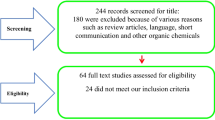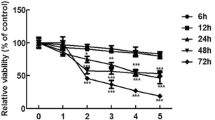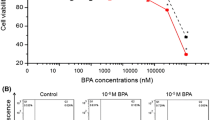Abstract
Purpose
There are many arguments on the carcinogenic potential of bitumen extract. The mechanism of bitumen-induced damage is not well understood at the molecular level. Therefore, in the present study, cell-transforming and tumor-inducing potential of bitumen extract was studied using in vitro [human osteosarcoma (HOS) cells] and in vivo [nude and severe combined immunodeficiency (SCID) mice] models.
Methods
Gas chromatography/mass spectrometry (GC/MS) analysis was carried out to find out the existence of carcinogenic compounds in the bitumen extract. Cell transformation test, anchorage independence assay, karyotyping assay, tumorigenicity assay, and 2-DE analysis were used to find out the effect of bitumen using the in vitro and in vivo models.
Results
GC/MS analysis showed the existence of carcinogenic compounds in the bitumen extract. HOS cells were treated with different concentrations (25, 50, and 100 μl/ml) of bitumen extract. Compared to the parental HOS cells, bitumen transformants (HOS T1 and HOS T2) showed the characteristics of anchorage independency, chromosomal anomaly, and cellular transformation. Interestingly, bitumen transformants were not able to form tumor in nude/SCID mice. Proteomic analysis revealed the existence of 19 differentially expressed proteins involved in progression of cancer, angiogenesis, cell adhesion, etc.
Conclusions
Exposure of bitumen extract to HOS cells results in the cellular transformation similar to cancer cells and can modulate proteins involved in the progression of cancer. We state that the non-tumorogenic potential of bitumen transformant in nude/SCID mice can be attributed to the downregulation of galectin-1, chromodomain helicase DNA-binding protein 1-like gene, and membrane-associated guanylate kinase 2 protein.





Similar content being viewed by others
References
Boulter E, Garcia-Mata R, Guilluy C, Dubash A, Rossi G, Brennwald PJ, Burridge K (2010) Regulation of Rho GTPase crosstalk, degradation and activity by RhoGDI1. Nat Cell Biol 12:477–483
Bourée P, Blanc-Valleron MM, Ensaf M, Ensaf A (2011) Use of bitumen in medicine throughout the ages. Hist Sci Med 45:119–125
Burgaz S, Erdem O, Karahalil B, Karakaya AE (1998) Cytogenetic biomonitoring of workers exposed to bitumen fumes. Mutat Res 419:123–130
Burr G, Tepper A, Feng A, Olsen L, Miller A (2002) Health hazard evaluation report: crumb-rubber modified asphalt paving: occupational exposures and acute health effects. Cincinnati, OH, US Department of Health and Human Services. Centers for Disease Control and Prevention, National Institute for Occupational Safety & Health (NIOSH HETA NO. 2001-0536-2864)
Campo L, Calisti R, Polledri E, Barretta F, Stopponi R, Massacesi S, Bertazzi PA, Fustinoni S (2011) Assessment of exposure to polycyclic aromatic hydrocarbons in asphalt workers by measurement of urinary 1-hydroxypyrene. Med Lav 102:484–493
Chaudhary A, Pechan T, Kristine LW (2006) Differential protein expression of peroxiredoxin I and II by benzo(a)pyrene and quercetin treatment in 22Rv1and Pr EC prostate cell lines. doi:10.1016/j.taap..12.030
Chen L, Chan TH, Yuan YF, Hu L, Huang J, Ma S, Wang J, Dong SS, Tang KH, Xie D, Li Y, Guan XY (2010) CHD1L promotes hepatocellular carcinoma progression and metastasis in mice and is associated with these processes in human patients. J Clin Invest 120:1178–1191
Cimmino F, Schulte JH, Zollo M, Koster J, Versteeg R, Iolascon A, Eggert A, Schramm A (2009) Galectin-1 is a major effector of TrkB-mediated neuroblastoma aggressiveness. Oncogene 28:2015–2023
Cram LS, Bartholdi MF, Ray FA, Travis GL, Kraemer PM (1983) Spontaneous neoplastic evolution of Chinese hamster cells in culture: multistep progression of karyotype. Cancer Res 43:4828–4837
DECOS (2007) Dutch Experts Committee on Occupational Standards of Health Council of the Netherlands. Bitumen (vapour and aerosol). Health-based recommended occupational exposure limit. Publication no. 2007/01 (R) OSH. www.healthcouncil.nl
Demydenko D, Berest I (2009) Expression of galectin-1 in malignant tumors. Exp Oncol 31:74–79
Driver JA, Lu KP (2010) Pin1: a new genetic link between Alzheimer’s disease, cancer and aging. Curr Aging Sci 3:158–165
Erenpreisa JE, Ivanov A, Dekena G, Vitina A, Krampe R, Freivalds T, Selivanova G, Roach HI (2000) Arrest in metaphase and anatomy of mitotic catastrophe: mild heat shock in two human osteosarcoma cell lines. Cell Biol Int 24:61–70
Fan G, Fan Y, Gupta N, Matsuura I, Liu F, Zhou XZ, Lu KP, Gélinas C (2009) Peptidyl-prolyl isomerase Pin1 markedly enhances the oncogenic activity of the rel proteins in the nuclear factor-kappaB family. Cancer Res 69:4589–4597
Funke L, Dakoji S, Bredt DS (2005) Membrane-associated guanylate kinases regulate adhesion and plasticity at cell junctions. Annu Rev Biochem 74:219–245
Goyak KO, McKee RH, Minsavage GD, McGowan C, Daughtrey WC, Freeman JJ (2011) Paving asphalt products exhibit a lack of carcinogenic and mutagenic activity. Int J Toxicol 30:492–497
Gunning WT, Goldblatt PJ, Stoner GD (1992) Keratin expression in chemically induced mouse lung adenomas. Am J Pathol 140:109–118
Hansen E (1989) Cancer mortality in the asphalt industry: a ten year follow up of an occupational cohort. B J Ind Med 46:582–585
Hinds PW, Dowdy SF, Eaton EN, Arnold A, Weinberg RA (1994) Function of a human cyclin gene as an oncogene. Proc Natl Acad Sci USA 91:709–713
IPCS (2004) International Programme on Chemical Safety, Asphalt (bitumen), World Health Organization, Concise international chemical assessment document. 59
Järvholm B, Nordström G, Högstedt B, Levin JO, Wahlström J, Ostman C, Bergendahl C (1999) Exposure to polycyclic aromatic hydrocarbons and genotoxic effects on nonsmoking Swedish road pavement workers. Scand J Work Environ Health 25:131–136
Karaman A, Pirim I (2009) Exposure to bitumen fumes and genotoxic effects on Turkish asphalt workers. Clin Toxicol (Phila) 14:1–6
Kuramitsu Y, Taba K, Ryozawa S, Yoshida K, Zhang X, Tanaka T, Maehara S, Maehara Y, Sakaida I, Nakamura K (2010) Identification of up- and down-regulated proteins in gemcitabine-resistant pancreatic cancer cells using two-dimensional gel electrophoresis and mass spectrometry. Anticancer Res 30:3367–3372
Lauby-Secretan B, Baan R, Grosse Y, El Ghissassi F, Bouvard V, Benbrahim-Tallaa L, Guha N, Galichet L, Straif K (2011) Bitumens and bitumen emissions, and some heterocyclic polycyclic aromatic hydrocarbons. Lancet Oncol 12:1190–1191
Lin X, Dowjat WK, Costa M (1994) Nickel-induced transformation of human cells causes loss of the phosphorylation of the retinoblastoma protein. Cancer Res 54:2751–2754
Lu PJ, Zhou XZ, Liou YC, Noel JP, Lu KP (2002) Critical role of WW domain phosphorylation in regulating phosphoserine binding activity and Pin1 function. J Biol Chem 277:2381–2384
Ma C, Wang J, Luo J (2003) Exposure to asphalt fumes activates activator protein-1 through the phosphatidylinositol 3-kinase/Akt signaling pathway in mouse epidermal cells. J Biol Chem 278:44265–44272
Marceau N, Schutte B, Gilbert S, Loranger A, Henfling ME, Broers JL, Mathew J, Ramaekers FC (2007) Dual roles of intermediate filaments in apoptosis. Exp Cell Res 313:2265–2281
Mascolo MG, Perdichizzi S, Rotondo F, Morandi E, Guerrini A, Silingardi P, Vaccari M, Grilli S, Colacci A (2010) BALB/c 3T3 cell transformation assay for the prediction of carcinogenic potential of chemicals and environmental mixtures. Toxicol In Vitro 24:1292–1300
McClean MD, Kelsey KT, Sison JD, Quesenberry CP Jr, Wrensch MR, Wiencke JK (2011) A case–control study of asphalt and tar exposure and lung cancer in minorities. Am J Ind Med 54:811–818
Miller AK, Burr GA (1998) Health hazard evaluation report: Bardon-Trimount, Stoughton, Massachusetts. Cincinnati, OH, US Department of health and human services, public health service, Center for disease control and prevention. National Institute for Occupational Safety and Health (NIOSH HETA No. 97, 0232–2674)
Miller AC, Blakely WF, Livengood D, Whittaker T, Xu J, Ejnik JW, Hamilton MM, Parlette E, John TS, Gerstenberg HM, Hsu H (1998) Transformation of human osteoblast cells to the tumorigenic phenotype by depleted uranium-uranyl chloride. Environ Health Perspect 106:465–471
Miller AC, Mog S, McKinney L, Luo L, Allen J, Xu J, Page N (2001) Neoplastic transformation of human osteoblast cells to the tumorigenic phenotype by heavy metal-tungsten alloy particles: induction of genotoxic effects. Carcinogenesis 22:115–125
Morrison DK (2009) The 14-3-3 proteins: integrators of diverse signaling cues that impact cell fate and cancer development. Trends Cell Biol 19:16–23
Mure K, Uddin AN, Lopez LC, Styblo M, Rossman TG (2003) Arsenite induces delayed mutagenesis and transformation in human osteosarcoma cells at extremely low concentrations. Environ Mol Mutagen 41:322–331
Neal CL, Yao J, Yang W, Zhou X, Nguyen NT, Lu J, Danes CG, Guo H, Lan KH, Ensor J, Hittelman W, Hung MC, Yu D (2009) 14-3-3zeta overexpression defines high risk for breast cancer recurrence and promotes cancer cell survival. Cancer Res 69:3425–3432
Partanen T, Boffetta P (1994) Cancer risk in asphalt workers and roofers: review and meta-analysis of epidemiologic studies. Am J Ind Med 26:721–740
Paulsson K, Johansson B (2007) Trisomy 8 as the sole chromosomal aberration in acute myeloid leukemia and myelodysplastic syndromes. Pathol Biol (Paris) 55:37–48
Rabinovich GA (2005) Galectin-1 as a potential cancer target. Br J Cancer 92:1188–1192
Rani AS, Qu DQ, Sidhu MK, Panagakos F, Shah V, Klein KM, Brown N, Pathak S, Kumar S (1993) Transformation of immortal, non-tumorigenic osteoblast-like human osteosarcoma cells to the tumorigenic phenotype by nickel sulfate. Carcinogenesis 14:947–953
Rhim JS, Jin S, Jung M, Thraves PJ, Kuettel MR, Webber MM, Hukku B (1997) Malignant transformation of human prostate epithelial cells by N-nitroso-N-methylurea. Cancer Res 57:576–580
Ruhl R, Musanke U, Kolmsee K, Prieß R, Zoubek G, Breuer D (2006) Vapours and aerosols of bitumen: exposure data obtained by the German Bitumen Forum. Ann Occup Hyg 50:459–468
Ryo A, Liou YC, Lu KP, Wulf G (2003) Prolyl isomerase Pin1: a catalyst for oncogenesis and a potential therapeutic target in cancer. J Cell Sci 116:773–783
Shen W, Liu H, Yu Y (2007) Proteomic analysis of cellular responses to different concentrations of anti-benzo(a)pyrene-7,8-dihydrodiol-9,10-epoxide in human amniotic epithelial FL cells. J Proteome Res 6:4737–4748
Sidhu MK, Fernandez C, Khan MY, Kumar S (1991) Induction of morphological transformation, anchorage-independent growth and plasminogen activators in non-tumorigenic human osteosarcoma cells by lead chromate. Anticancer Res 11:1045–1053
Skalnikova H, Martinkova J, Hrabakova R, Halada P, Dziechciarkova M, Hajduch M, Gadher SJ, Hammar A, Enetoft D, Ekefjard A, Forsstrom-Olsson O, Kovarova H (2010) Cancer drug-resistance and a look at specific proteins: Rho GDP-dissociation inhibitor 2, Y-box binding protein 1 and HSP70/90 organising protein in proteomics clinical application. J Proteome Res. doi:0.1021/pr100468w
Sobus JR, McClean MD, Herrick RF, Waidyanatha S, Onyemauwa F, Kupper LL, Rappaport SM (2009) Investigation of PAH biomarkers in the urine of workers exposed to hot asphalt. Ann Occup Hyg 53:51–60
Stie J, Fox D (2008) Calcineurin regulation in fungi and beyond. Eukaryot Cell 7:177–186
Suzuki M, Piao CQ, Zhao YL, Hei TK (2001) Karyotype analysis of tumorigenic human bronchial epithelial cells transformed by chrysolite asbestos using chemically induced premature chromosome condensation technique. Int J Mol Med 8:43–47
Tempest PR, Reeves BR, Spurr NK, Rance AJ, Chan AM, Brookes P (1986) Activation of the met oncogene in the human MNNG-HOS cell line involves a chromosomal rearrangement. Carcinogenesis 7:2051–2057
Tong A, Zhang H, Li Z, Gou L, Wang Z, Wei H, Tang M, Liang S, Chen L, Huang C, Wei Y (2007) Proteomic analysis of liver cancer cells treated with suberonylanilide hydroxamic acid. Cancer Chemother Pharmacol 61:791–802
Traxler RN (1936) The physical chemistry of asphaltic bitumen. Chem Rev 19:119–143
USEPA (1995) Methods for the Determination of Organic Compounds in Drinking Water. USEPA, U.S. Environmental Protection Agency, National Exposure Research Laboratory, USEPA, Ohio. EPA −600/R-95/131
Van Metre PC, Majewski MS, Mahler BJ, Foreman WT, Braun CL, Wilson JT, Burbank TL (2012) Volatilization of polycyclic aromatic hydrocarbons from coal-tar-sealed pavement. Chemosphere (in press)
Wang JJ, Marshall WD, Frazer DG, Law B, Lewis DM (2003) Characterization of DNA adducts from lung tissue of asphalt fume-exposed mice by nanoflow liquid chromatography quadrupole time-of-flight mass spectrometry. Anal Biochem 322:79–88
Xie H, Holmes AL, Wise SS, Huang S, Peng C, Wise JP (2007) Neoplastic transformation of human bronchial cells by lead chromate particles. Am J Respir Cell Mol Biol 37:544–552
Zhang B, Zhang Y, Dagher MC, Shacter E (2005) Rho GDP dissociation inhibitor protects cancer cells against drug-induced apoptosis. Cancer Res 65:6054–6062
Zhu H, Gooderham N (2002) Neoplastic transformation of human lung fibroblast MRC-5 SV2 cells induced by benzo[a]pyrene and confluence culture. Cancer Res 62:4605e9
Zlatko P, Pavelic Z, Slocum HK, Rustum YM, Creaven PN, Nowak J (1980) Constantine growth of cell colonies in soft agar from biopsies of different human solid tumors1 Karakousis, Hiroshi Takita, and Arnold Mittelman. Cancer Res 40:4151–4158
Acknowledgments
The authors are thankful to the Council of Scientific and Industrial Development (C.S.I.R.) for providing the funds through CSIR Network Project and to Advanced Centre for Treatment, Research and Education in Cancer (ACTREC), Khargar, Navi Mumbai, India for providing the necessary help.
Author information
Authors and Affiliations
Corresponding author
Additional information
Responsible editor: Philippe Garrigues
Rights and permissions
About this article
Cite this article
Dhondge, A., Surendran, S., Seralathan, M.V. et al. Cellular alterations and modulation of protein expression in bitumen-challenged human osteoblast cells. Environ Sci Pollut Res 19, 4030–4041 (2012). https://doi.org/10.1007/s11356-012-0879-z
Received:
Accepted:
Published:
Issue Date:
DOI: https://doi.org/10.1007/s11356-012-0879-z




